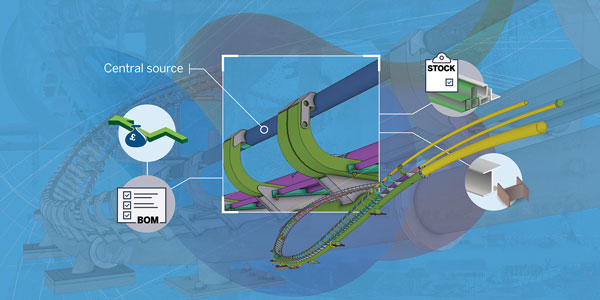Projects and Features
Taking back control
Trimble [UK] Digital Construction Process Manager Duncan Reed explains how the construction industry can navigate material shortages and price rises.
Whatever the reason for it, from the Coronavirus pandemic and the impact of Brexit to bottlenecks in the global supply chain and increased market demand, you don’t need me to tell you that the landscape presently facing steelwork contractors and fabricators is, at its best, challenging. As well as the worryingly limited availability of materials, escalating costs have laid waste to businesses profit margins; and with order books healthy to bursting, these market instabilities are having even more of an impact.
Price increases may be expected; however, it’s perhaps the vast increase in material costs over such a short duration that has caused the level of disruption we are currently seeing. According to the latest government figures, building materials prices have risen by nearly 15 percent over the past year, on average; while the price of fabricated steel jumped 5.9 per cent in May and overall was up more than 38 per cent, year-on-year.
Given this volatile landscape, the need to design smart, reduce waste and manufacture and estimate more efficiently has perhaps never been so important, with digital technology a key facilitator of this.
Estimate smart
In many ways, the profitable success of a project, is determined right from the initial tender and bidding stage. Failure to submit an accurate tender could result in the steelwork contractor losing the bid or even failing to make a profit further down the line, especially when margins are so tight in this current economic climate.
With digital technology, such as BIM software, employed within your business, you can benefit from having a central source of information: the 3D model. With connected and integrated data, you can then use this model to automatically generate a bill of materials – one that you can trust to be accurate. It’s thanks to this level of automation and the more informed estimates that it can enable, that you can protect the all-important profit margin, with less likelihood of having inaccurate quantity take-offs and bids.
Buy smart
All of that said, it’s not enough to just estimate smart – you need to buy smart, too. Here, again, digital technology can be invaluable, helping to contribute to a more informed and efficient procurement process.
While some steelwork contractors continue to rely on traditional paper-based methods to track the materials entering and products leaving their plant, employing a digital information management system can offer enhanced visibility and traceability. Trimble’s Tekla PowerFab is one such example, with the software used by South Durham Structures throughout their fabrication workflow.
Speaking on its value at the procurement stage, Keith Corner, Operations Director, said: “Easy to use and offering enhanced levels of visibility, we now no longer have to manually and physically check what stock we already have, compared to what stock we need to purchase on every job. Instead, it’s all automated, providing us with a far better and more informed way to handle stock. We can simply import files from the drawing office and the digital system will do the rest!”
Having this access to live stock information has perhaps never been so important, enabling businesses to make smarter purchasing decisions and help ensure that you always have the materials needed to complete a job.
Fabricate smart
Of course, it is the fabrication workshop that’s at the heart of any steelwork contractor’s business. It’s here where steelwork is made… and money can be lost.
In order to fabricate and manufacture more efficiently, high levels of accuracy are imperative. It’s no secret that errors made at the fabrication stage can lead to material wastage, project delays and the all-important profit margin taking a hit – all things that contractors need to be avoiding, now more than ever.
With 3D modelling software, you can benefit from enhanced visibility, high levels of detail and information-rich data. This, combined with features such as clash detection and automatic generation of fabrication drawings, schedules and other documentation from the central 3D model, can enable a more accurate design and fabrication process, with fewer errors.
Supply chain bottlenecks and rising prices are issues that are facing the construction industry today. As such, it’s important for steelwork contractors and fabricators to take control, where they can, and help steer their business through these challenging times. Digital software, such as Trimble’s Tekla PowerFab, may not be able to solve the problems but it can help to provide enhanced accuracy, visibility and traceability throughout the fabrication process, putting you back in control.
To learn more about Tekla PowerFab, the complete steel management software suite designed specifically for steelwork contractors, please visit: www.tekla.com/uk.














